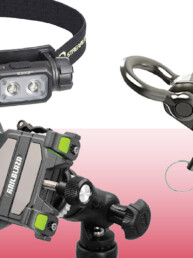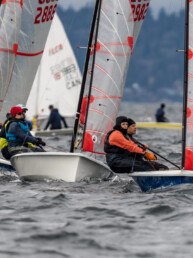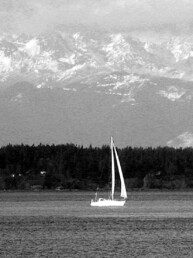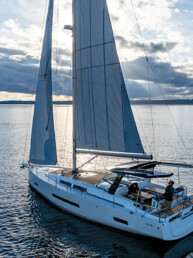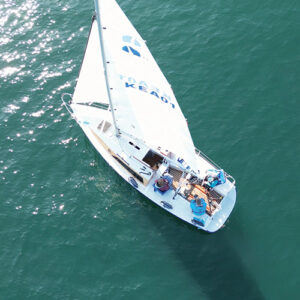 In our latest My Boat column, we’d like to introduce you to Casey Wilkinson and his sweet looking Didi 23, Koru. After searching for several years for a sailboat that he could use with his family, Casey decided to build the boat by himself from a set of plans, starting in May of 2020 and launching in October of 2022. He wanted something that had enough room to sleep four, had a separate enclosed head, decent headroom, and could be trailered and launched easily. With its raising keel, the Didi 23 design ticked those boxes beautifully, and can fit on a low trailer and be launched at almost any ramp. Koru is homeported on Bainbridge Island, Washington, where Casey operates a small boat building outfit called Kea Custom Boats.
In our latest My Boat column, we’d like to introduce you to Casey Wilkinson and his sweet looking Didi 23, Koru. After searching for several years for a sailboat that he could use with his family, Casey decided to build the boat by himself from a set of plans, starting in May of 2020 and launching in October of 2022. He wanted something that had enough room to sleep four, had a separate enclosed head, decent headroom, and could be trailered and launched easily. With its raising keel, the Didi 23 design ticked those boxes beautifully, and can fit on a low trailer and be launched at almost any ramp. Koru is homeported on Bainbridge Island, Washington, where Casey operates a small boat building outfit called Kea Custom Boats.
Tell us about your boat’s name.
Koru is a word from the New Zealand Maori language. It is the word for the new shoots of the New Zealand Silver Fern. It also has deeper meanings related to re-birth, new beginnings, growth, and strength. This is the first keelboat I have built for my family, and this name came to mind thinking of all the new adventures we would have on her.
Tell us a little about your boating background. Have you owned other boats before this one?
I have a long background with boats. Being a former marine biologist and dive instructor, I have experience on everything from 10-foot skiffs to 225-foot research vessels. Now, I run my own small boat building company, and between personal and professional projects, I have built more than 50 boats including kayaks, 15-foot powerboats, sailing dinghies, rowboats, and my Didi 23. Most of my sailing experience has been in smaller dinghy-sized boats between 10 and 15 feet long.
Who designed the Didi 23?
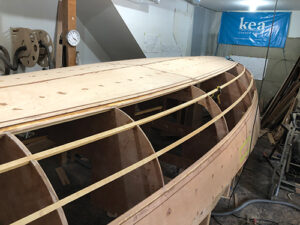
The Didi 23 was designed by Dudley Dix. It is based on the Didi 26, which is one of Dudley’s most popular designs. The 23 has almost the same lines as the 26, but the bow area is 3 feet shorter and there’s a smaller keel bulb. I built it for my own use, and as a display for my company.
The boat is built from 9 mm okoume marine grade plywood that has been fiberglassed on the outside and epoxy sealed on the inside. Stringers are made from Alaskan yellow cedar, and hardwood accents and the keel foil are made from Sapele. The cabin and cockpit sole are made from teak and holly marine plywood. She weighs (on the trailer) about 2,500 pounds. The keel is a foil shape with an 850 pound lead bulb on the bottom. Her draft is about 18 inches with the keel raised and 5-feet-7-inches with the keel down. The keel is raised using a synthetic line reeved through a custom-built pulley system to one of the cabin top winches. The top of the keel comes out through the cabin top and the bulb sits up against the bottom of the hull.
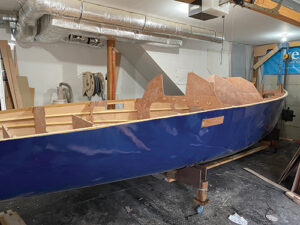
I decided to add a sugar scoop transom, which extended the LOA to 24-feet-8-inches. The waterline was also lengthened to about 23.5 feet. The sugar scoop is a great place to board the boat from the dock, and even better from the water if anyone were to go for a swim. I decided to mount the rudder on a shaft instead of using gudgeons and pintles, so I did not have to cut a large V out of the bottom of the scoop. The rudder is a balanced spade style and the shaft goes up through custom carbon tubes to the tiller head. The entire assembly is mounted on the transom using a piano hinge. This allows the entire rudder (with a small section of the scoop) to swivel up for trailering.
I don’t like the aesthetic of an outboard hanging off the back of a small sailboat, and wanted to keep things quiet, so I opted to install a 1kw electric pod drive by ePropulsion. I decided to make the motor retractable to lessen drag when sailing, and to keep it out of the water when moored at my marina.
Describe your personal experience of the build process?
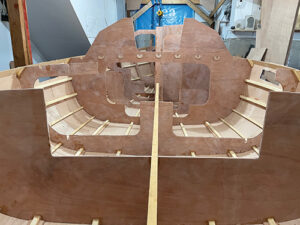
The building process was extremely rewarding and, overall, it took me about 2,000 hours over 2 years and 4 months. I have built many boats, but never one this large. The biggest learning curve for me was in designing and installing systems. I spent a good two weeks talking about how I was going to store fresh water, much to my family’s dismay, and I ended up settling on portable plastic carriers. The most fun was learning how to create a full electrical system from the ground up, setting up the running rigging, and completing all the canvas work (though I didn’t make the sails). The hardest parts were figuring out how to flip the hull, getting the boat on the trailer, and devising a system for stepping the mast.
Another challenging part was sourcing all the hardware. I spent many evenings trying to find just the right hinge or through-hull fitting, only to realize that it was the wrong size or I forgot to purchase fasteners for it. Moreover, I learned that any little change I made—such as changing the shape of the companionway—led to several hours worth of work figuring out the cascade of changes that followed.
The most rewarding part, by far, is sailing at 6.5 knots on a beam reach knowing that I built this boat myself!
How did this build process compare to other builds you’ve completed?
Since I have built quite a lot of wooden boats using a variety of techniques, the process for this one was similar to many previous builds, with a new twist. The hull for Dudley Dix’s Didi series is built using a technique called “radius chine.” This involves using marine plywood (9mm in my case) to create the flat areas of the hull sides and V bottom. The rounded chine is then made from two layers of 4mm ply. The deck is then created with a traditional stitch and glue method. The entire boat is covered in fiberglass with some sections of unidirectional carbon fiber for strength.
What do you like best about your boat?
I love the racy lines and incredible performance, yet how comfortable it is inside. The fastest I have had her up to so far has been 7.2 knots (above hull speed) on a broad reach under the reefed main alone. There is another Didi 23 in Hood River, Oregon that reportedly has hit 15 knots using an asymmetrical spinnaker. The cabin has a very roomy double berth up forward and two extra long quarter berths under the cockpit.
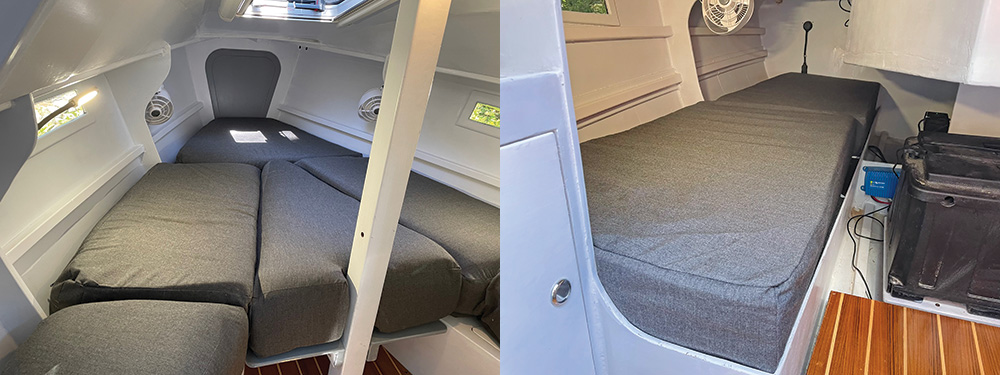
What do you know now about your boat that you wish you’d known when you built it? Would that have changed your mind?
I wish I had known that the pandemic would drastically increase the cost of all the supplies, especially stainless and silicon bronze fasteners.
What’s your favorite story involving your boat?
My wife and I were out for an afternoon sail when another sailboat came close to ask us questions about Koru. We stayed close for a few minutes then headed back to our respective docks. The two men on the other boat then came and found us as we were buttoning up our boat. We talked for about 20 minutes and they were very complimentary about our boat. After they walked away, my wife looked at me and said, “You know who that was, right? That was Jay Inslee!”
Describe the most challenging situation you’ve experienced on your boat and how it performed.
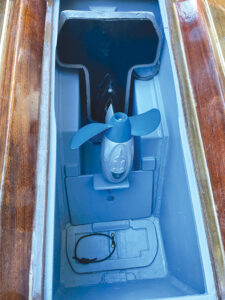
The most challenging situation I experienced was when I moved the boat from the ramp in Kingston to my slip on Bainbridge. There wasn’t a breath of wind and I hadn’t really tested the motor yet, since this was the first time going farther than a half a mile beyond the ramp. We were motoring very slowly for about 45 minutes and then stopped to let a super-pod of Orcas go by (a super-pod is when members of all three Southern Resident Killer Whale families are spotted together). After they moved along, we were running out of time before sunset so I sped up to full throttle. The battery emptied after about a minute. I had drained the single 1-kw-hour battery too far. I carry a generator, but it was taking too long to recharge the battery, so I had to get towed into Bainbridge. I now carry a spare battery so I can charge one while using the other during long passages with no wind.
Where do you plan to take your boat? Do you have a dream destination?
I would love to take Koru up the Inside Passage and all over the Salish Sea.
If someone gave you $10,000 that you could only spend on your boat, what would you do with it and why?
I would buy enough battery capacity to allow me to motor at full throttle for at least 5 hours, and I would also buy a new Code 0 for better light air performance.
If you could have any other boat, what would it be and why?
I would love to have a boat large enough to live on and cruise to far flung places like the South Pacific.
Want to share the story of your boat in a future column? Contact andy@48north.com.
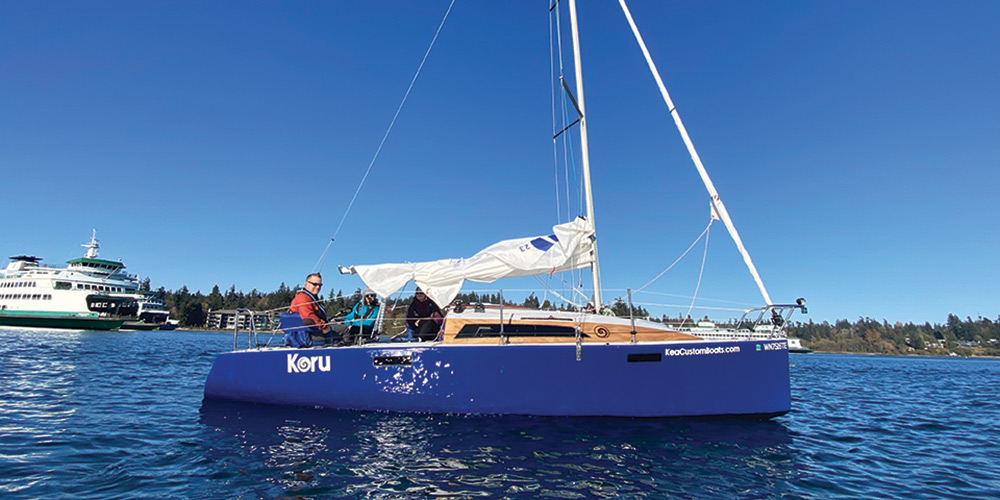
Editor
48° North Editors are committed to telling the best stories from the world of Pacific Northwest boating. We live and breathe this stuff, and share your passion for the boat life. Feel free to keep in touch with tips, stories, photos, and feedback at news@48north.com.

